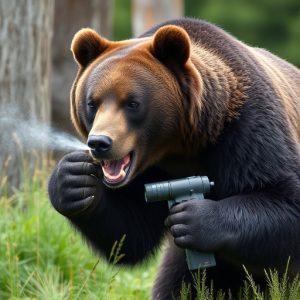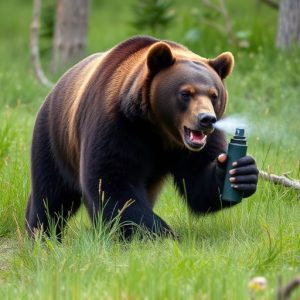Bear Repellent Spray: Effectiveness, Usage Tips, and Understanding Bear Behavior
Understanding bear behavior is crucial for camper safety in wild areas, as bears are attracted to fo…….
Understanding bear behavior is crucial for camper safety in wild areas, as bears are attracted to food sources. While bear spray deters aggressive behavior, its effectiveness varies based on bear type, timing, and proximity; research shows black bears may still approach if they smell food. Combining bear spray with proper food storage, noise making, and alertness, along with choosing high-quality equipment and understanding usage guidelines, is vital for enhancing safety in grizzly country.
“Enhancing your camping experience and ensuring safety in bear country is now a simple carry-on—bear repellent spray. This essential tool has revolutionized outdoor adventures, offering a robust defense against potential encounters with these majestic yet unpredictable creatures. In this article, we explore the effectiveness of bear spray through comprehensive research, delving into bear behavior, the science behind its active ingredients, and practical guidelines for optimal use during your next camping trip.”
- Understanding Bear Behavior and Their Attraction to Campers
- The Science Behind Bear Repellent Spray: Active Ingredients and Efficacy
- Best Practices for Using and Carrying Bear Spray While Camping
Understanding Bear Behavior and Their Attraction to Campers
Understanding bear behavior is crucial for campers heading into wild areas, as it can greatly impact their safety. Bears are generally wary of humans and tend to avoid encounters, but they also have a keen sense of smell and are attracted to food sources. Campers often inadvertently invite bears to their camp by leaving food unattended or storing it improperly. Black bears, in particular, are known for their curiosity and willingness to forage for easy meals. Research has shown that bears can detect human food from far distances, with some studies indicating they have a remarkable ability to remember the locations of food sources.
When it comes to bear spray, research on its effectiveness is mixed. Bear spray is designed to deter bears by creating an unpleasant experience through irritation and pain. However, its success depends on various factors, including the type of bear, the timing of the encounter, and the proximity of the spray to the bear. Studies have shown that black bears often avoid areas treated with bear spray but may still approach campers if they believe there is food nearby. Therefore, while bear spray can be an essential tool for deterring aggressive behavior, it should be used in conjunction with proper food storage practices and awareness of local bear habits.
The Science Behind Bear Repellent Spray: Active Ingredients and Efficacy
The effectiveness of bear repellent spray, often referred to as bear spray, is rooted in its active ingredients and how they interact with bears’ senses. These sprays typically contain capsaicin, a compound found in chili peppers, which irritates a bear’s eyes, nose, and respiratory system. This irritation triggers a strong reaction in the bear, causing it to avoid the area.
Research on bear spray effectiveness is varied. Studies show that when used correctly, bear repellent spray can deter aggressive bears and significantly reduce the risk of attacks. However, factors like distance, weather conditions, and the specific type of spray can impact its efficacy. How Effective Is Bear Spray in real-world scenarios remains a topic of ongoing research, emphasizing the importance of understanding and following proper usage guidelines for optimal protection while camping or hiking in bear country.
Best Practices for Using and Carrying Bear Spray While Camping
When using bear spray while camping, understanding its effectiveness and proper application is crucial for your safety in grizzly country. According to research, bear spray can be highly effective in deterring aggressive bears if used correctly. It’s important to note that no single deterrent guarantees 100% protection against bear attacks, but combining it with other precautions like making noise while hiking, keeping food securely stored, and staying alert can significantly reduce risks.
For optimal results, choose a canister designed for outdoor use with a range of at least 20 feet. Before heading out, familiarize yourself with the spray’s mechanism: ensure you know how to activate it quickly and easily. During encounters, aim for the bear’s face and eyes, as this area is most sensitive. Keep the canister close at hand; always store it securely in an easy-to-reach pocket or belt loop, not in your backpack where it might shift and become inaccessible during a sudden encounter. Regularly inspect the spray for any signs of damage or leakage to ensure its functionality throughout your trip.
Bear repellent spray is a crucial addition to your camping essentials, especially in areas with bear populations. The research on its effectiveness is promising, with studies showing that when used properly, it can significantly reduce bear-human conflicts. By understanding bear behavior and following best practices for application and storage, campers can enhance their safety and enjoy a more peaceful outdoor experience. Remember, knowledge and preparation are key to navigating the great outdoors safely.


